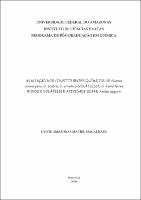| ???jsp.display-item.social.title??? |


|
Please use this identifier to cite or link to this item:
https://tede.ufam.edu.br/handle/tede/3320| ???metadata.dc.type???: | Dissertação |
| Title: | Avaliação dos constituintes químicos de Guarea convergens, G. scabra, G. silvatica (voláteis) e G. humaitensis (fixos e voláteis) e atividade sobre Aedes aegypti |
| ???metadata.dc.creator???: | Magalhães, Lyege Amazonas Maciel  |
| ???metadata.dc.contributor.advisor1???: | Lima, Maria da Paz |
| ???metadata.dc.description.resumo???: | A família Meliaceae tem ocorrência pantropical e compreende cerca de 700 espécies distribuídas em 50 gêneros. Os principais metabólitos secundários da família são limonóides, terpenóides, esteróides e flavonóides. O gênero Guarea compreende cerca de 50 espécies encontradas na América tropical e na África cujos estudos sobre os constituintes químicos são restritos a cerca de 10 espécies, onde foram identificados principalmente sesqui, di e triterpenos e limonóides. Este trabalho visou avaliar os constituintes químicos de Guarea convergens, G. scabra, G. silvatica (voláteis) e G. humaitensis (voláteis e fixos) e a atividade sobre Aedes aegypti, principal espécie transmissora da dengue. Assim, amostras vegetais coletadas na Reserva Ducke foram submetidas a hidrodestilação para obtenção de óleos essenciais e/ou macerados para obtenção de extratos orgânicos. Os óleos essenciais obtidos mostraram a predominância de sesquiterpenos. Nos galhos de G. convergens os majoritários foram α-santaleno (26,26%), α-copaeno (14,61%), drima-7,9(11)-dieno (6,85%) e β-santaleno (6,32%), e no óleo dos galhos de G. humaitensis predominaram o epóxido de cariofileno (40,91%), epóxido de humuleno II (14,43%) e β-bisaboleno (8,36%). Em folhas de G. scabra, os componentes majoritários foram cis-cariofileno (33,37%) e α-trans-bergamotemo (11,88%) e G. silvatica epóxido de cariofileno (36,54% folhas; 8,57% galhos), espatulenol (14,34% galhos e 4,17% folhas) e β-elemeno (6,20% folhas), além do diterpeno kaureno em folhas (15,61%). O estudo fitoquímico dos extratos de folhas e galhos de G. humaitensis conduziu a obtenção de uma mistura dos sesquiterpenos epóxido de cariofileno e epóxido de humuleno II, mistura dos esteróides β-sitosterol e estigmasterol, um novo limonóide do tipo mexicanolideo, 2-desoxigrandifolídeo A, a cumarina escopoletina e o triterpeno cicloar-23-en-3β,25-diol. Dentre os óleos essenciais testados frente às larvas de A. aegypti, o óleo dos galhos de G. humaitensis apresentou a maior atividade larvicida (CL50= 49,0 μg.mL-1). |
| Abstract: | The Meliaceae family has pantropical occurrence and include around 700 species distributed in 50 genus. The main secondary metabolites of the family are limonoids, terpenoids, steroids e and flavonoids. The Guarea genus found in Tropical America and Africa contains about 50 species, of which around 10 species have chemical studies. The studies showed that sesqui-, di-, triterpenes and limonoids are the main constituents. This work aimed to evaluate the chemical constituents of Guarea convergens, G. scabra, G. silvatica (volatile) and G. humaitensis (volatile and non-volatile) and the activity against Aedes aegypti, the main species transmitter of the dengue. In this manner, vegetal samples collected in the Ducke Reserve were submitted to hydrodistillation to obtain essential oil and/or macerated to obtain the organic extract. The essential oils obtained showed the predominance of sesquiterpenes. In the branches of G. convergens the majority components were α-santalene (26.26%), α-copaene (14.61%), drim-7,9 (11)-diene (6.85%) and β-santalene (6.32%), and in the oil of G. humaitensis branches predominated the caryophyllene epoxide (40.91%), humulene epoxide II (14.43%) and β-bisabolene (8.36%). In leaves of G. scabra, the majority components were cis-caryophyllene (33.37%) and α-trans-bergamotene (11.88%), and in G. silvatica, caryophyllene epoxide (36.54% leaves; 8.57% branches), espatulenol (14.34% branches and 4.17% leaves) and β-elemene (6.20% leaves), further the kaurene diterpene in leaves (15.61%). The phytochemical study of extracts of leaves and branches of G. humaitensis lead to obtaining a mixture of sesquiterpenes caryophyllene epoxide and humulene epoxide II, mixture of steroids β-sitosterol and stigmasterol, a new limonoid of the mexicanolide type, 2-deoxygrandifolide A, the coumarin scopoletin and the triterpene cycloart-23-ene-3β,25-diol. Among essential oils tested against the larvae of. A. aegypti, the oil of the G. humaitensis branches presented the best larvicidal activity (49,0 CL50= μg.mL-1). |
| Keywords: | Limonóide mexicanolídeo Desoxigrandifolídeo A Guarea Óleo essencial Aedes aegypti Limonoid mexicanolide essential oil Guarea |
| ???metadata.dc.subject.cnpq???: | CIÊNCIAS EXATAS E DA TERRA: QUÍMICA |
| Language: | por |
| ???metadata.dc.publisher.country???: | BR |
| Publisher: | Universidade Federal do Amazonas |
| ???metadata.dc.publisher.initials???: | UFAM |
| ???metadata.dc.publisher.department???: | Instituto de Ciências Exatas |
| ???metadata.dc.publisher.program???: | Programa de Pós-graduação em Química |
| Citation: | MAGALHÃES, Lyege Amazonas Maciel. Avaliação dos constituintes químicos de Guarea convergens, G. scabra, G. silvatica (voláteis) e G. humaitensis (fixos e voláteis) e atividade sobre Aedes aegypti. 2009.120 f. Dissertação (Mestrado em Química) - Universidade Federal do Amazonas, Manaus, 2009. |
| ???metadata.dc.rights???: | Acesso Aberto |
| URI: | http://tede.ufam.edu.br/handle/tede/3320 |
| Issue Date: | 21-Dec-2009 |
| Appears in Collections: | Mestrado em Química |
Files in This Item:
| File | Description | Size | Format | |
|---|---|---|---|---|
| Dissertacao- Lyege Magalhaes.pdf | 5.84 MB | Adobe PDF |  Download/Open Preview |
Items in DSpace are protected by copyright, with all rights reserved, unless otherwise indicated.




